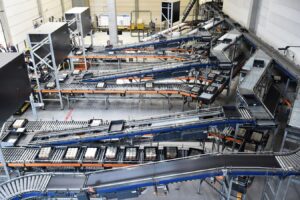Walmart is doubling down on its grocery business as more consumers turn to the company for their food needs.
The nation’s largest retailer reported in the prior quarter that sales at U.S. stores rose 5.3% as it continued to gain market share in the grocery and general merchandise categories.
Part of the reason its seeing growth within the grocery segment, which has seen an uptick in costs from inflation, is that the company is remodeling the produce sections of its stores, and increasing the assortment of food that it’s offering, according to Walmart CFO John David Rainey.
WALMART BEATS WALL STREET EXPECTATIONS, RAISES OUTLOOK AS IT OFFERS MORE GROCERY DISCOUNTS
“It’s [ the produce section] very attractive. We’ve got a very high quality produce offering for people and it invites them in,” Rainey said. “It’s a much broader assortment than what we’ve had historically.”
The company has been building new modernized stores and remodeling hundreds of others. Over the past three years, it remodeled about 700 stores each year on average, and it plans to convert more in the coming year. The company’s new and updated stores include improved layouts, bigger product selection, refreshed signs, paint and shopping carts.
Aside from its improved aesthetic, Rainey also credited its private brand as another driver. Walmart is seeing an increase in private brands as a larger share of overall sales, driven partly by consumers’ focus on price during high inflation. Earlier this year, the company launched its latest and most expansive private label brand, Bettergoods, which encompasses 300 items including frozen, dairy, snacks, beverages, pasta, soups, coffee and chocolate.
Not only is the company offering a more expansive selection of food within the private label, but the quality of the food has improved as well, Rainey said.
“It’s much broader and appeals to a lot more customers and members,” Rainey said, adding that “the quality is just much different than what you’ve seen historically.”
He also highlighted that consumers’ growing reliance on convenience is benefiting Walmart. According to Rainey, one-third of their customers are paying extra for expedited food delivery through Walmart’s delivery services.
SOME WALMART EMPLOYEES WEARING BODY CAMERAS IN STORES FOR SAFETY
This comes as the $25 billion merger between Albertsons and Kroger crumbles amid concerns from federal regulators that the deal would undermine competition in the grocery industry. The deal would have been the largest merger in the history of the grocery industry.

But U.S. District Judge Adrienne Nelson said that the plan put forward by the two companies to reduce grocery prices and divest more than 500 stores failed to address concerns about reduced competition in the sector and the impact it could have on consumers and workers.
Albertsons, which subsequently sued Kroger for not working hard enough to secure the merger, claimed the deal would have expanded competition, lowered prices, increased associate wages, protected union jobs, and enhanced customers’ shopping experience.
As of September, Albertsons Companies operated 2,267 retail food and drug stores with 1,726 pharmacies, 405 associated fuel centers, 22 dedicated distribution centers and 19 manufacturing facilities.
Meanwhile, Kroger operates 2,750 grocery retail stores under a variety of banner names, including Kroger, Ralphs, Dillons, Smith’s, King Soopers, and Fred Meyer.
In the U.S., Walmart operates just over 4,600 stores. This doesn’t include its membership warehouse, Sam’s Club, which house about 600 locations around the nation.
Read the full article here
















